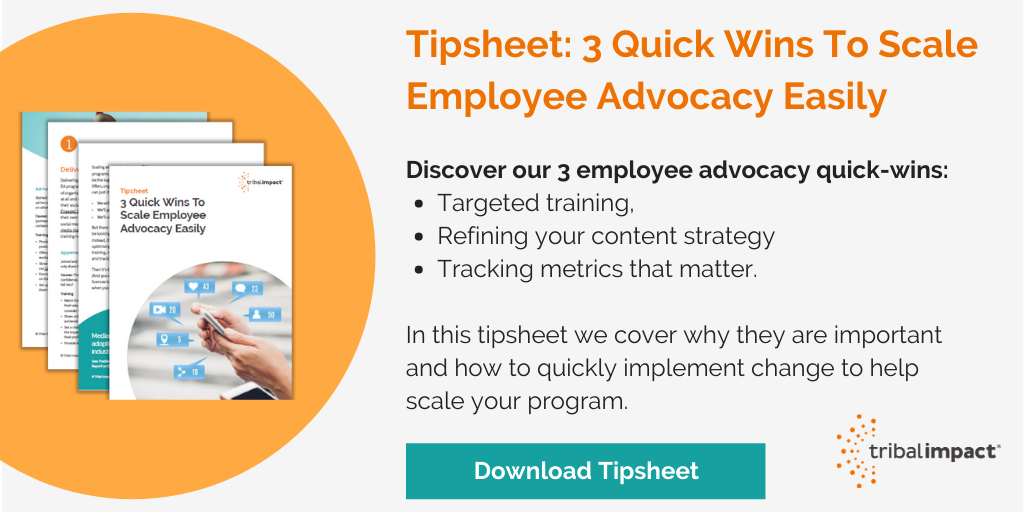Relying on economies of scale for your employee advocacy program seems like a sensible approach. Still, it's usually the opposite of what's needed.
%20compressed.jpg?width=658&name=3%20Ways%20To%20Quickly%20Scale%20Your%20Employee%20Advocacy%20(2)%20compressed.jpg)
Research from LinkedIn shows that employees collectively have social networks an average of 10x more than the corporate employer brand. It's therefore no wonder that scaling employee advocacy focuses on signing up more users.
Yet more users doesn't always result in better results. Only some employees have the potential to become employee advocates and LinkedIn's research shows that 30% of a business' total engagement typically comes from just 3% of employees.
Scaling down your licences is the answer. That way, you can free up resources for providing targeted training, optimising your content strategy and tracking the metrics that really matter.
PRIORITY 1 : Deliver Targeted Training

There is a world of difference between organisations that are best-in-class at employee advocacy and just average or, worse, lagging. And almost always, it comes down to inadequate or untailored training.
Every employee is different. They have their own unique goals, personalities and knowledge of using social media, which you can map to 9 different stages of social media maturity.
- Inactives: Inactive employee advocates often don't see the value in using professional networking sites, or they lack confidence.
- Connectors, Participators & Broadcasters: These employees may have started testing the waters, but their approach is often ad-hoc and lacks any real participation on others' post. They require a preciser strategy which aligns with their own unique goals.
- Networkers: B2B salespeople often fall into this category, posting self-promotional content once or twice a day. They may have forgotten social etiquette norms (or they may just be going through the motions as they believe cold calling is still the answer).
- Collaborators & Enthusiasts: These employees are doing such a good job of engaging on social media that it's easy to think that they require no more training. In fact, they're the ones you should be focusing on, to turn them into Thought Leaders or Industry Influencers.
A one-size-fits-all approach is therefore not the answer.
PRIORITY 2: Optimise Your Content Strategy

Content lies at the heart of any successful employee advocacy program. However, it doesn't always align with what your audience wants to read - be that the topic, content format or length.
Even today, companies are failing to use employee advocacy for what it is - a social tool. 96% of buyers say that the quality of content is often tarnished by being too sales-focused (Source: Demand Gen 2019 Content Preferences Report).
There's also usually a difference between what employees like to share and what their audience engages with. Employees typically (and naturally) wish to share their personal and company's success stories. Yet, their audience are on LinkedIn to learn and develop, so they prefer educational and informative content.
It's essential to understand your goals. If you want to cultivate a great culture that helps retain employees and attract talent, then personal and company success stories are a positive thing. Yet if your primary goal is to attract and nurture prospects and existing clients, then you'll need to encourage sharing content that helps your audience or encourages a debate.
The first step is defining what your optimum balance is. Then look to your data to identify common themes and ways you can optimise your content further to help you achieve your goals.
PRIORITY 3: Measure & Report: Beyond Clicks, Comments, Likes And Shares

Even though marketing departments know that they need to prove ROI, there is still often a focus on what CEOs believe are vanity metrics. As Fournaise’s Global CEO and Marketing Performance Chief, Jerome Fontaine said in CEOReview.com:
“Over the years, we’ve tracked that today’s Marketers have been making two key mistakes: The first, they live too much in their creative, digital, and social media bubble, focusing on the “big creative idea” and/or on parameters such as “likes”, “tweets”, “feeds” or “followers” – parameters that they can't really prove/generate more quantifiable customer demand for their products/services. These very parameters are judged by CEOs as “interesting but not critical”.”
Their study supports this, alarming finding that:
- 77% of marketers believe that generating (incremental) brand awareness was a critical way to prove the effectiveness of their marketing
- 71% believe the next best way to demonstrate effectiveness is to look at engagement figures
- Of these marketers, 86% mistake engagement for conversion.
In the beginning, vanity metrics such as likes, clicks, shares and comments are often all you have to prove that your program is gaining traction. Yet after 6 to 9 months, you won't get budget approval to scale your program unless you can show the ROI for sales revenue, employee engagement and talent acquisition.
With the right strategy in place, you can quickly turn around an underperforming or struggling employee advocacy program into one exceeding industry benchmarks. The next stage in your journey requires integrating Employee Advocacy with Social Selling and Influencer Marketing. Discover, with compelling and relevant content at the heart of your strategy.


